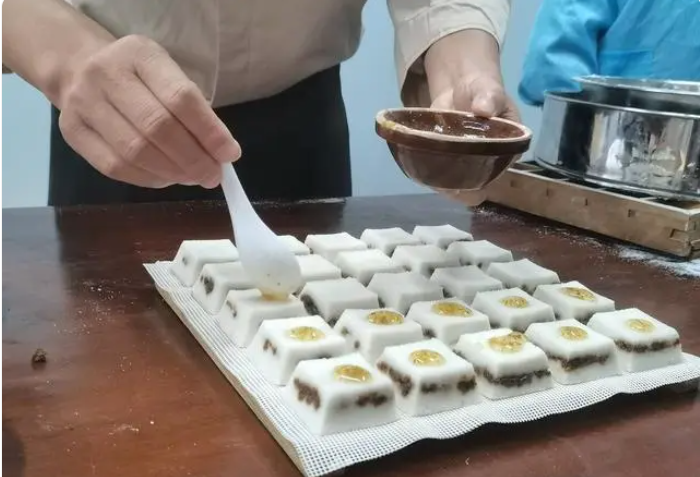Lingui Osmanthus Cake is a traditional snack in Lingui County, Guilin City, famous for its sweet and delicious taste, smooth and delicate texture. Osmanthus Cake is made from fresh local osmanthus flowers, with a pleasant and fragrant taste that leaves a lasting impression.

Guilin, Guilin, is a forest of osmanthus trees, and osmanthus flowers are naturally abundant. In Guilin, whether in the urban or rural areas, there is a traditional pastry called osmanthus cake made from osmanthus flowers.
In the streets and alleys of Guilin, there are many small stalls selling osmanthus cakes with small trailers. When it comes to the long history, it is none other than the osmanthus cake made in Jinyuan, Wangjiashan Village, Zhongyong Town, Lingui District.
Wangjiashan Village in Zhongyong Town is an ancient village mainly inherited by the Wang family. Wang Baoliang, born in the 1970s, grew up here.
According to Wang Baoliang, the Wang family was originally from Zhejiang and settled in Wangjiashan, Guangxi. They gradually grew into a large family in the area. The tradition of making pastries has existed in the Jiangsu and Zhejiang regions for a long time. In addition, Guilin has always been popular for major festivals, visiting relatives to make pastries as sacrifices, and giving gifts to relatives. The Wang family ancestors began to try to combine the local characteristics and actual needs of Guilin, constantly improving and developing the pastry making techniques brought from Jiangsu and Zhejiang. After trial and error, the Wang family gradually formed pastries with family characteristics, and osmanthus cake is one of them.

According to the family history of the Wang family, in the second year of Xianfeng in the Qing Dynasty (1852), Wang Chengshi (1796-1875) led the villagers in building and cultivating the land in his hometown. It happened to be the season when osmanthus flowers were in full bloom, and sticky rice and glutinous rice were also the ingredients used by the people in their daily cake making. Wang Chengshi used the family's inherited cake making skills to make osmanthus cakes. Afterwards, he used the family's art of making osmanthus cakes as a means of livelihood and named it the private courtyard "Yiyuan". Later, due to the characteristics of osmanthus cakes being freshly eaten and fresh, they needed to be sold on the streets and alleys. Therefore, male members of the family were the main inheritors, supplemented by women, and passed down from generation to generation.
Influenced by his ancestors' production of osmanthus cake, Wang Baoliang has developed a strong interest in making osmanthus cake since childhood and has inherited his father's skills in making it. Nowadays, he not only fully masters all the traditional techniques of osmanthus cake making, but also is the seventh generation inheritor of the family's osmanthus cake making skills. In October 2023, his osmanthus cake making skills were included in the ninth batch of autonomous region level intangible cultural heritage list.
